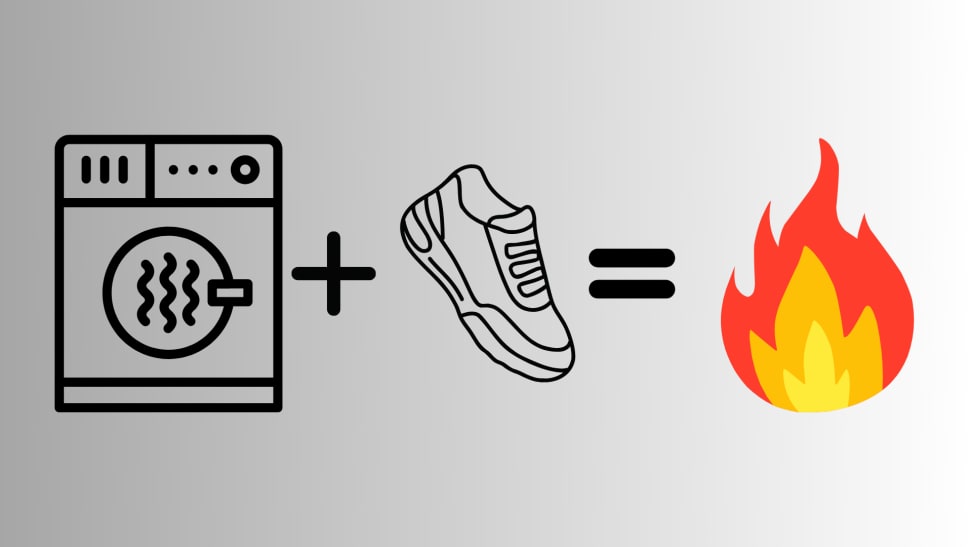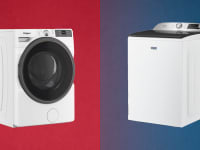 Credit:
Reviewed
Credit:
Reviewed
Products are chosen independently by our editors. Purchases made through our links may earn us a commission.
People love clothes dryers, and no wonder: They're an appliance that can save you hours of work every month—and fast. The best dryers can get the moisture out of your washing in a fraction of the time that air-drying can.
It can be tempting to throw things other than linens and garments into your dryer. But, just because you can do something doesn't mean that you should do something.
Sure, most people understand that jamming too much laundry into your dryer at once can damage the machine and not really dry your clothing that well. However, there are several items you may question—they seem like they'd do fine in the dryer, but can actually be damaged or, worse, damage your dryer.
To help you avoid a costly laundry blunder, we've put together a list of the top 10 things you should never, ever put in the dryer.
10 things you should never put in the dryer
1. Bath mats
Throwing your freshly washed bath mat in the dryer is a great way to ruin it.
“The high heat from the dryer will cause the rubber to break down and crack, making the mat less effective. It can also be a fire hazard, and little rubber bits will get all over the dryer and any other items in the dryer with it, which is a pain,” says Laura Johnson, a former consumer analyst at LG Home Appliances, now at Hisense.
If you absolutely must put a bathmat in the dryer, set it to tumble dry on its lowest heat setting. Ideally, you should dry your bathmats by hanging them up on a clothesline or towel rack in a well-ventilated area. If you’re drying it flat, there are worse places to do it than on top of your dryer while it’s running: The heat that radiates from the machine is enough to help the drying process along, but not hot enough to cause any damage.
2. Clothes with paint stains
Hey Picasso, wanna set your house on fire? Throwing clothes with paint or nail polish on them is a great place to start. Those are chemical stains you’re dealing with. Unless the stain from the paint came out while being washed, your sullied garment shouldn’t go in the dryer.
“Whether it's a cleaner or a polish, lots of chemicals are combustible,” meaning that once they hit the dryer, there could be a dryer fire. “Better safe than sorry—hang-dry that,” says Jon Chan, Reviewed’s former senior lab technician and laundry expert.
As an alternative, you’ll want to think about hanging your painter’s smock or overalls out to dry. Hanging them outside will ensure they dry without the risk of starting a fire in your house. It’ll also allow the chemicals in the paint to off-gas and dissipate into a wide-open space.
3. Gym clothes & equipment
Most gym clothes are made with spandex, which is prone to damage and shrinkage if you put it in the dryer, says Chip Smith, former chief marketing officer of Sears Home Services.
You won’t notice that the clothes will be ruined right away. In many cases, the garments will break down over time. Hang them dry to get the most out of pricey workout wear from brands like Lululemon and Under Armor. Oh, and if you’re a fan of leggings, you’ll want to take a few extra steps to take care of them.
Drying sports equipment like shin guards, hockey pads, or a football helmet requires similar care to your gym clothes. Generally, the instructions for washing items like these are to let them soak in soapy water, then hand wash or scrub them down with a brush, and then rinse them with clean water until all traces of soap and filth are gone. And then—you guessed it—air dry it.
4. Footwear and shoes
Should you put your shoes in the dryer? No. Do people do it anyway? You bet. Although you can wash sneakers in the washing machine, you should leave your kicks out to dry instead of tossing them in the dryer.
“The high heat can cause the rubber in the shoes and soles to shrink, which will affect cushioning, and possibly the fit of the shoe itself,” says Johnson.
Depending on the type of shoe you’re dealing with, you may also have to contend with the heat of a dryer, making the glue it is put together with come apart, or the shoe being damaged by being tossed inside the machine’s tumbler.
5. Clothing with electrical components
Many articles of clothing these days have electrical components sewn into them, including heated vests and gloves, beanies with headlamps, and even socks equipped with pedometers.
At high temperatures, solder and plastic circuit boards can be damaged. Tumbling around in a hot dryer can cause lithium-ion batteries to explode or ignite. It’s better to either remove the electronic components from the clothing you’re washing and drying or, leave it out to air dry. As with any clothing you own, check the washing instructions for the best way to take care of your fancy electronic underwear.
6. Excess dryer sheets and fabric softener
If you love soft, static-free clothes, chances are good that you use a fabric softener or dryer sheets as part of your laundry routine. If you use more than a single dryer sheet with your clothes, you may notice they have a waxy feel when you take them out of the dryer. There is such a thing as too much of a good thing. Too much soap, softener, or dryer sheets in your load can cause clothes to feel slick instead of soft.
“Too many surfactants, which are chemical compounds found in [detergents], will coat the inside of the dryer drum, moisture sensors, lint screen, and vent system,” says Smith. Instead, use dryer balls.
7. Sandy towels and clothes
You love beach days, but your clothes dryer doesn’t. Sand in the moving parts of your dryer can wear down rubber components, cause friction, and grind against metal, making a terrible racket.
If you’re just drying off your towels and don’t feel that they need a wash, be sure to shake the heck out of them first. They must be free of any sand they picked up while you were lounging by the sea.
8. Swimsuits
Speaking of beach days, let’s talk about swimsuits. Always lay your bathing suits flat to dry. Always
“The high heat of the dryer will cause the spandex in your swimsuit to weaken and break down, leading to stretched-out swimsuits and see-through areas,” says Johnson. Make sure you're washing your bathing suits correctly to ensure you get as many dips out of them as possible.
9. Natural fibers
Johnson recommends keeping any clothes made of animal-based materials, like wools, cashmere, silk, and leather, out of the dryer. They can shrink, lose shape, or get pilly. Your leather or pleather clothes can crack, warp, and pucker with the heat of the dryer. Read the care instructions on your garments to find out how to take care of your clothes.
10. Bras & delicates
It is best to hang-dry all of your bras, regardless of whether they are lace, spandex, silk, satin, or cotton. The dryer heat and tumbling can cause the material to weaken and bras to lose their shape, says Johnson.
The same can be said for other delicates, like lingerie, slips, and hosiery: the heat and rough treatment that they receive in a dryer will prematurely age the fabric.
One of our favorite tricks for prolonging the life of a bra is to wash it in a salad spinner. We know it sounds crazy. But give it … a spin.
11. Beaded embellishments
If your clothes are adorned with beads, sequins, or other accoutrements, you should avoid putting the garment in the dryer. If the adornments are held on with glue, the heat of a dryer cycle could melt it, causing your fancy beaded blouse to be ruined. If that doesn't do it, you still need to look out for the rough tumbling action of the dryer drum. None of it is designed to be kind to such delicately decorated duds.
12. Belts
Putting anything with a belt on it in a dryer is a bad way to go. As your clothing tumbles, the belt buckle could do serious damage to the other clothes in the dryer. Consider laying these garments out flat to dry.
What is the role of a clothes dryer?
As its name suggests, a clothes dryer is designed to dry your clothing, bedding, and other fabric goods by removing moisture, typically after they’ve been run through a washing machine.
How does a dryer work?
There are several kinds of dryers, but they all dry clothes in much the same way. Using a combination of tumbling to ensure clothing dries evenly, heat from a heating element, and enough airflow to ensure that the heat moves throughout the tumbling drum evenly, and slowly drawing out the moisture in the fabric.
As the water evaporates inside the dryer, it’s removed by the airflow inside the drum. When the dryer’s moisture sensor notes that the humidity inside the drum has been lowered to an acceptable level, it ends the drying cycle.
Dryer use and risks
While using a clothes dryer offers the luxury of convenience and speed when it comes to drying your freshly washed clothes, using one is not without risks.
According to the National Fire Protection Association (NFPA), clothes dryers are responsible for an average of 13 deaths, 440 injuries, and 14,970 fires every year.
The key reason for these statistics? The failure on the part of users to clean their lint traps after every use, and not keeping a reasonable cleaning schedule for dryer vents.
If your clothes feel excessively hot or it takes longer to dry them than it should, there’s a good chance that your dryer’s vent is clogged with lint. This prevents airflow. To help reduce the risks associated with this, be sure to clean out your lint trap regularly–we recommend doing so after every dryer cycle. You’ll also want to have your dryer vent professionally cleaned at least once a year. Doing so can go a long way toward ensuring that your dryer works as it should.
Resources



